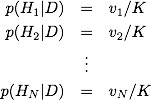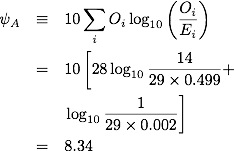I recently listened to an interview with Francis Collins on Point of Inquiry, concerning his book The Language of God: A Scientist Presents Evidence for Belief. Francis Collins is an icon of the "scientist who is also Christian" (along with Ken Miller). He's a converted atheist, now evangelical Christian, but is pro-evolution, director of the NIH, and the former director of the Human Genome Project. I was immediately struck by two things:
- he was converted to Christianity primarily by the arguments in Mere Christianity, by C.S.Lewis. In this book, one of the main arguments centers around the Moral Law, it's universality and internal (to the human) nature of it. I'll go into that more later.
- he is obviously a very smart guy, so his opinions (especially on evolution) need to be taken seriously (at least once). So when he claims that the Moral Law cannot be the product of evolution, one had to at least not write that comment off immediately.
So, I went back and read Mere Christianity, which I had done in college some years back. I had an immediate visceral reaction against it, as he laid out these philosophical arguments that seemed much more like word games and bald assertions than anything approaching truth. I admit that I am steeped in the methods of science, and find arguments that claim surety yet are not testable to be empty. In reading Francis Collins' book, I have found that his arguments are essentially identical to Lewis', but couched in more modern scientific language. (As a footnote, I was, pleasantly surprised to see that Lewis lumped evolution with gravitation in describing laws of nature.)
Moral Law and the Argument for God
The definition of Moral Law here is:
"denunciations of oppression, murder, treachery and falsehood; the same injunctions of kindness to the aged, the young, and the weak, of almsgiving and impartiality and honesty" [pg 24, Collins quoting from Lewis)
The argument for God based on the Moral Law takes on three components. The three components of the argument are the following:
- Moral Law is universal to all human cultures.
- Moral Law includes pure altruistic behavior (think Mother Theresa or Oskar Shindler here), which cannot be explained by evolution
- Moral Law is internal to humans.
(There is a fourth point, which Lewis ties specifically to Christianity, which is that we often choose not to obey this Moral Law. This sets up the idea of free will, and the idea of sin.)
Why is altruism a problem for evolution? Collins writes:
Agape, or selfless altruism, presents a major challenge for the evolutionist. It is quite frankly a scandal to reductionist reasoning. It cannot be accounted for by the drive of individual selfish genes to perpetuate themselves. Quite the contrary: it may lead humans to make sacrifices that lead to great personal suffering, injury, or death, without any evidence of benefit. And yet, if we carefully examine that inner voice we sometimes call conscience, the motivation to practice this kind of love exists within all of us, despite our frequent efforts to ignore it.
He outlines three common evolutionary arguments for the origin of Moral Law:
- One proposal is that repeated altruistic behavior of the individual is recognized as a positive attribute in mate selection. But this hypothesis is in direct conflict with observations in nonhuman primates that often reveal just the opposite—such as the practice of infanticide by a newly dominant male monkey, in order to clear the way for his own future offspring.
- Another argument is that there are indirect reciprocal benefits from altruism that have provided advantages to the practitioner over evolutionary time; but this explanation cannot account for human motivation to practice small acts of con- science that no one else knows about.
- A third argument is that altruistic behavior by members of a group provides benefits to the whole group. Examples are offered of ant colonies, where sterile workers toil incessantly to create an environment where their mothers can have more children. But this kind of "ant altruism" is readily explained in evolutionary terms by the fact that the genes motivating the sterile worker ants are exactlythe same ones that will be passed on by their mother to the siblings they are helping to create. [pg 27-28]
So, if you accept these points, then Collins writes:
If the Law of Human Nature cannot be explained away as cultural artifact or evolutionary by-product, then how can we account for its presence? There is truly something unusual going on here. To quote Lewis, “If there was a controlling power outside the universe, it could not show itself to us as one of the facts inside the universe—no more than the architect of a house could actually be a wall or staircase or fireplace in that house. The only way in which we could expect it to show itself would be inside ourselves as an influence or a command trying to get us to behave in a certain way. And that is just what we do find inside ourselves. Surely this ought to arouse our suspicions?”
Encountering this argument at age twenty-six, I was stunned by its logic. Here, hiding in my own heart as familiar as anything in daily experience, but now emerging for the first time as a clarifying principle, this Moral Law shone its bright white light into the recesses of my childish atheism, and de- manded a serious consideration of its origin. Was this God looking back at me? [pg 29]
An Analogy
When I read arguments of this sort, especially the last quote from Lewis, I am offended by the confidence of the language from a totally flimsy and untestable statement: "The only way in which we could expect [a controlling power] to show itself would be inside ourselves as an influence or a command trying to get us to behave in a certain way" [emphasis mine]. Really? How do you get that? How can you test that claim? How do you know what options are open for a controlling power? Aren't you already assuming that there is something inside us, beyond natural law (i.e. dualism), in order for this to be true?
I'd like to propose an analogy. I am not sure how far this will go, and where it will break down (as all analogies do), but I think it makes a point. There is a universal law, which I will call the Eating Law. According to this law we as humans have an internal voice telling us that we want to eat fatty foods.
- The Eating Law is universal to all human cultures. We differ on the specifics, but we all have the voice telling us what we want to eat (i.e. pringles, Big Macs, etc...)
- Eating Law includes pure gluttony as a behavior (think people who eat themselves to obesity and death) which cannot be explained by evolution. how could behavior that reduces life expectancy, mating probability, and health possibly be selected for? There are people who eat so much they can't even move!
- Eating Law is internal to humans. We can look at the eating behavior, but we'll never be able to observe the actual urge to eat fatty foods.
- We often choose not to follow this law (i.e. we choose to eat salad instead of Big Macs)
This is not simply hunger, which we can see in other animals. It is an urge to eat, even when you're not hungry, fatty foods. Now, re-read Lewis:
“If there was a controlling power outside the universe, it could not show itself to us as one of the facts inside the universe—no more than the architect of a house could actually be a wall or staircase or fireplace in that house. The only way in which we could expect it to show itself would be inside ourselves as an influence or a command trying to get us to behave in a certain way. And that is just what we do find inside ourselves. Surely this ought to arouse our suspicions?”
Now, we have two such laws, the Eating Law and the Morality Law. Which one is the message from the creator? How could we test this? I could probably come up with more examples of universal tendencies which take the form of internal messages to humans, but I don't need to. Coming up with just one is enough to show how this argument is completely empty.
I am perplexed that someone as smart as Francis Collins can't see this. I am further perplexed that someone would be "shocked by the logic of this argument".
















